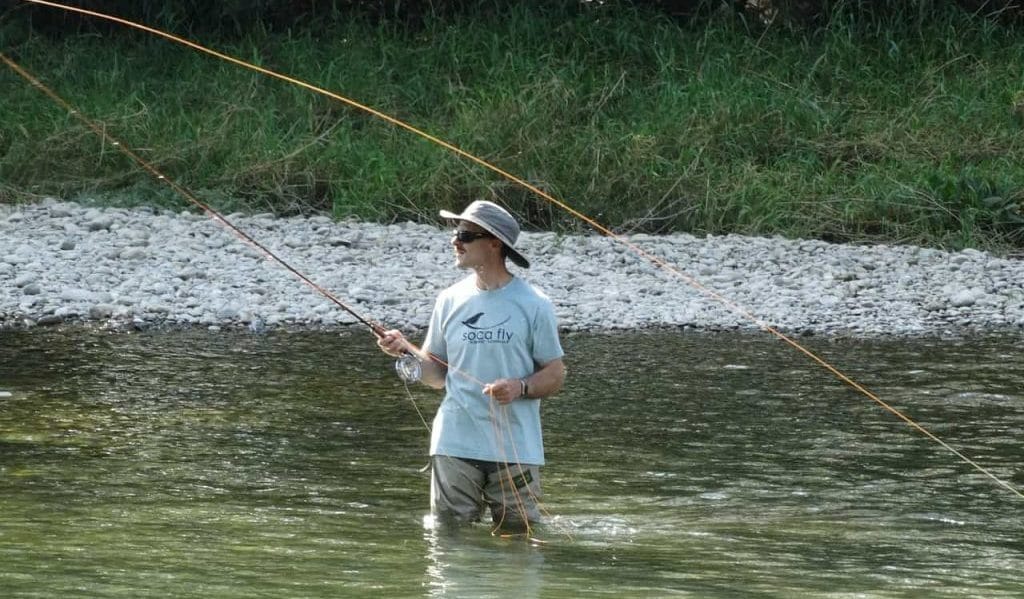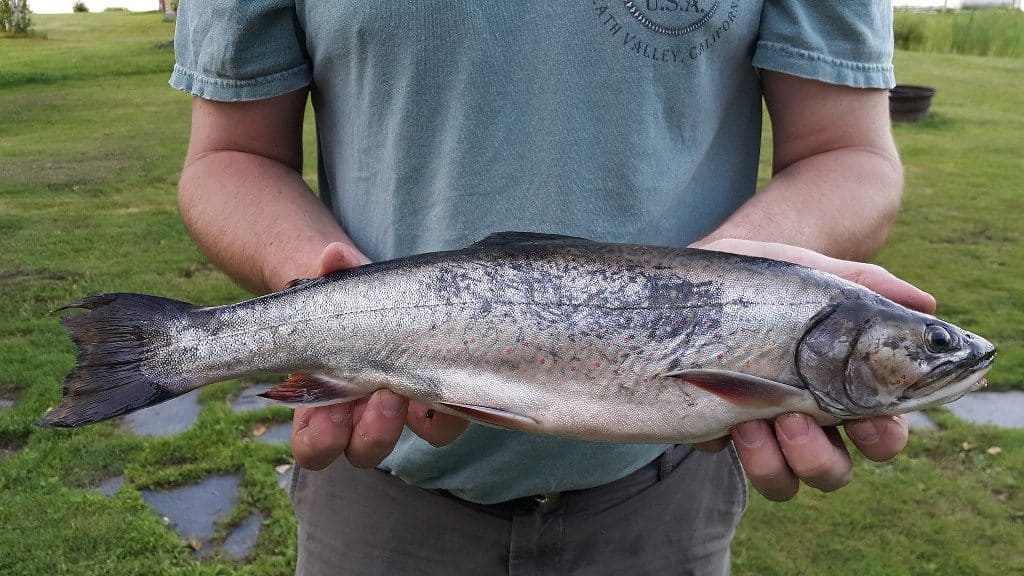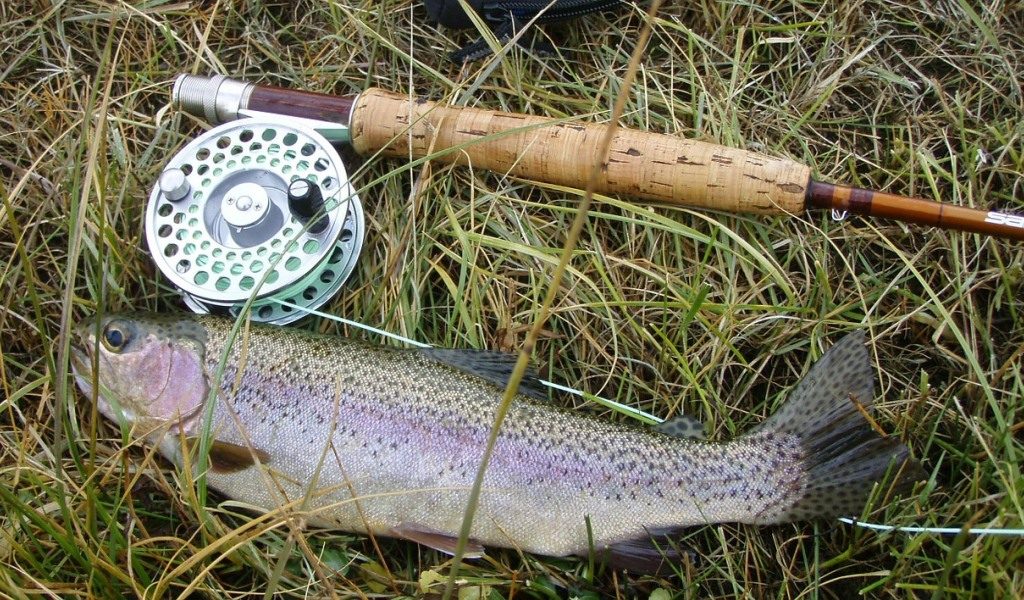Beginner Fly Fishing Gear Checklist: New to fly fishing? Don’t worry here is our fly fishing checklist for beginners. We’ll make sure you have everything you need to get started.
Our checklist can help you prepare for your first trip. Just pick everything on this list and you will not have to look back from your boat.
Beginner Fly Fishing Gear Checklist
We suggest beginners avoid highly sophisticated or expensive fly fishing equipment. Buy only the essential equipment when you are getting into the sport. You can upgrade your gear as you get more experience.
Tip: Most online stores have hundreds of reviews for popular or best-selling products. So, never buy any new equipment before carefully reading the reviews.
So now let’s move to our must-have fly fishing gear list starting with a fly rod, reel, line, and of course some flies.
1. Fly Rod and Reel

Fly fishing can turn out to be pretty expensive if you are not careful. There are all sorts of fly rods and reels that could entice you. But the truth is most beginners don’t need high-end equipment.
So don’t break the bank when you’re looking for new gear. You just need good quality, basic fly fishing reel, rod, and flies. We suggest you pick one of the best fly fishing combos under $300 to get started. It will save you from the trouble of finding matching equipment.
If you are a beginner, we suggest you first find out what species of fish you will be targeting. It can help you pick the right gear for your fishing trip.
You need smaller flies for small-sized fish and heavier flies for bigger fish. You need a 2wt or 3wt rod to cast smaller flies. But it is difficult to cast heavy flies with a 3wt fly rod. So, you will need a fly rod over 5wt to target bigger fish.
So if you are targeting smaller fish such as trout or panfish, you’ll need a 3wt fly rod and reel. But if you are targeting bass, you will need a 4wt or 5wt fly rod and reel.
You need a lightweight rod and smaller flies for trout fishing. While you will need a medium-sized rod and streamers for targeting bass. So, it is essential to choose your equipment as per the specific fish you plan to catch.
If you’re planning to fish in large rivers and streams, you will need a longer fly rod. It will help you cover more water and throw long-distance casts.
But it is okay to use a smaller fly rod on small rivers and streams. It will help you reach spots with more vegetation without getting your rod stuck.
Once you have more experience, you may not need a separate rod for every variety of fish you want to land. Most seasoned fly anglers have a couple of fly rods to catch different species.
Similarly, fly reels come in different arbor sizes and with different drag types. But you don’t need anything fancy when you’re looking for your first fly reel. Just pick a fly reel under $50 that matches your rod and line.
2. Fly Line and Backing

Fly Line is the link between the backing and the leader in your fly fishing setup. It is a thicker, brightly colored line with different designs known as tapers. You must understand how to select the right fly line and backing for a great experience.
You must consider two key factors while choosing your fly line.
First, the line weight must match the rod weight. Don’t get confused with the actual physical weight. Here we are referring to the designated weight class (wt). You can easily find a rod or line’s weight on the package.
For instance, you must pair a 4wt rod with a 4wt fly line. This ensures you have a balanced setup for casting and presentation.
Next, we suggest beginners go for an all-around fly line. While there are many different types of fly lines, an all-around line offers versatility. It will allow you to fish in different conditions without limitations.
Backing connects your fly line to the reel. It provides additional line capacity for situations when a fish makes a run. There isn’t much difference among various brands of backing. But just ensure you pick a durable and sufficiently long backing.
3. Leaders and Tippets

The leader refers to the tapered section of the line added to your main fishing line. Tapered Monofilament and Furled are the two most common types of leaders.
The leader is stiff from the butt section and tapers towards a thin front section. This helps the leader in carrying the energy from the cast to the fly. Without a tapering leader, your line would be limp preventing you from making the right presentation.
You can get leaders in a variety of sizes ranging from 0x to 7x. A leader with a lower number is thicker and renders more stiffness to the line. Light flies would be better supported by leaders 6x in size while heavy fish require 0x.
Tippet refers to the monofilament or fluorocarbon line you use to tie your fly. It connects the end of the leader to your fly. The tippet is different from the leader as it isn’t tapered. It has essentially the same thickness throughout. We suggest you attach a tippet when your leader’s thick portion has worn out.
You can easily find a leader and tippet online or from your local fly shop.
4. Dry Flies

Dry flies are the flies that float on the surface of the water. They imitate insects such as mayflies, spinners, adult caddis, cicadas, grasshoppers, and ants.
We suggest you find beforehand which insects hatch during your selected fishing season. Then get the flies that imitate those insects you would naturally find in that location.
Fish will not bite the flies that they don’t normally eat in a particular season. So you must try and find out the insects your target fish is most attracted to be successful with dry fly fishing.
5. Nymphs
Trout rely on nymph larvae and pupae for food. So you must consider how the fish normally eat them and then introduce your flies in a similar manner.
Trout lay at the bottom and don’t put much effort into catching nymphs. They try to catch the insects drifting by without hurrying.
Unlike other fish, trout wouldn’t come to the top to feed on your nymph. So you’ll have to introduce it subsurface where they can have easy access.
6. Streamers
Streamers are flies that imitate baitfish, minnows, and leeches. In other words, streamers refer to the meat menu of fish food.
Larger fish tend to prefer such baits as they need more meat in their diet. So big fish tend to pound on the protein-rich streamers. You should certainly hope for a big catch while using streamers.
7. Fly Box
It is easier to carry your collection of flies in a fly box. The flies stay organized making it easier to find the right fly at the right time. It is a treat for dedicated fly anglers to keep their beloved fly collection safe.
8. Line Nippers

Line nippers are an essential tool in fly fishing. But you may not realize their importance till you’ve been on an actual fly fishing adventure.
They come in handy when you have to remove the excess line while attaching new flies. You can do it even with nail clippers. But using line nippers is easier and better.
9. Strike Indicators

You may be aware of the conventional fishing bobber. Strike indicators are just fly fishing versions of them. They are mostly made of wool yarn, dry flies, and dense foams.
Most anglers use a strike indicator when using wet flies below the surface of the water. It can help you notice any movement or twitch which may signal the presence of fish underneath the water.
If you’re fishing with dry flies, then you must also use a fly floatant liquid or powder. It can help keep your dry fly floating on the water’s surface longer.
10. Rubber Fishing Net

Rubber nets are fish-friendly and easily available. Fishing with conventional nets can tear apart the delicate fish gills. But there is no chance of this happening with rubber nets.
The knotted netting of conventional nets can cut through the gills of the fish. So most fish end up getting injured in such nets.
11. Fishing Pliers
It is essential to have fishing pliers on the water. They give you extra reach and also improve your grip. It is easier to unhook stubborn fish with the help of fishing pliers. Some anglers use fishing pliers to pinch hook barbs.
12. Waders or Wading Boots

In case you are not comfortable with getting wet in the water, we suggest you get a good pair of fly fishing waders or wading boots.
Even if you like getting wet in the summer, getting water on yourself in winter is unimaginable. So a pair of waders can help you stay dry during your time on the water.
But you may not need a pair of waders if you plan on remaining on the bank.
13. Fishing Hat
Experienced anglers will always advise you to wear a fishing hat. It provides a good cover for your face and neck on hot sunny days. If you want to stay safe from sunburn injuries, never forget to bring your hat along.
14. Polarized Sunglasses
A pair of sunglasses can prove to be extremely beneficial for beginners. Polarized sunglasses not only protect your eyes from UV rays but also remove the glare or the reflection from the water. It allows you to clearly see the water depth and make out the distinction between rocks and fish.
15. Sunscreen
This may deem unnecessary to some people but there is no way you will get a nice tan while fishing. We suggest you use eco-friendly sunscreens to save yourself from irregular tan lines.
An eco-friendly sunscreen doesn’t pollute the water with the chemicals found in regular sunscreen lotions. Such chemicals could be very dangerous for fragile aquatic ecosystems.
16. First Aid Kit
You should always come prepared for the worst. Even simple injuries need basic care which you can only access with a first aid kit. It is also advisable to bring some insect repellant along. There could be more mosquitoes in those areas than you expect.
17. Rain Jacket

Never trust the weather forecasts. There is always a chance of rain near big water bodies. Make sure you wear a fly fishing rain jacket in the rain.
18. Get a Fishing License
You need a registered state fishing license to go out fishing in most states of the US. Not having a license or forgetting the license could land you in trouble.
State commissions do not accept apologies. They levy a fine almost double the cost of the license if you don’t have one on you.
This could amount to up to two hundred dollars. So, make sure you purchase a fishing license on time.
19. Check the Local Fishing Regulations
Rules and regulations vary from state to state and in various portions of the water of the same stream. Some sections of streams may permit the use of artificial lures while others may allow only catch and release.
Rules can also influence the length of your fly leader and the number of flies attached to your fly line. Many states do not allow more than 2 flies. If you are unaware of how federal and state regulations work, you could lose over a hundred dollars in fines.
Conclusion
You make the best use of our Beginner Fly Fishing Gear Checklist by researching your fishing spot before finalizing your fly fishing excursion. You can try finding out:
- Depth and condition of the water body.
- Weather conditions on your planned fishing day.
- The average temperature of the place.
A simple Google search can get you all the information you need. We suggest you also check online reviews of the place. It can help you find out the actual experience of the anglers who fly fish there. You can also check our Fly Fishing Tips for Beginners to help you fish like a pro!
Information about your selected fishing spot and the type of fish there can also help you pick the right gear. Once you’ve finalized your fishing spot, make sure you know the right directions to get there.
Check out the parking place around the spot before you leave. And, don’t forget to take some snacks along! We hope you find our Beginner Fly Fishing Checklist useful while planning your next fly fishing trip.
Last Updated on May 15, 2025 by Blaine Townsend




